Since the great financial crisis of 2008, there’s been a fundamental shift in the fixed-income landscape. Banks have been central to the creation of credit for consumers and small businesses, driven by their ability to take in low-cost deposits and loan money at higher rates. While non-bank loan channels have always existed parallel to traditional banking, these channels were historically small niches in the overall economy. However, a new breed of lender has emerged to become a significant presence in the market. Initially, they were known as “peer-to-peer lenders” or “marketplace lenders.” Today, these platforms, such as Lending Club, SoFi and Square, are recognized as “alternative lenders.” These technology-based lending businesses are disrupting the lending markets and have taken market share from traditional banks.
Structural Cost Advantage
Because alternative lenders are not burdened with either the substantial infrastructure of traditional banks (they don’t have physical branches) or the same level of regulatory oversight (banks are typically regulated by the full spectrum of state bank examiners, the FDIC, the SEC, the Federal Reserve and consumer credit agencies), they are able to offer loans at significantly lower rates. Alternative lenders have been able to leverage their superior operating efficiency to offer more attractive pricing to consumer and small business borrowers while also delivering a superior service experience.
The increasing cost structure at banks in the post-Dodd-Frank Act era makes it increasingly uneconomic to originate smaller business loans. With few viable alternatives, many small business owners have resorted to borrowing on credit cards, taking on debt that often has a punitively high, variable rate. As a result, alternative lending platforms have been steadily taking market share by catering to this underserved segment and cost-effectively originating smaller loans.
Source of Capital for Alternative Lenders
There were two significant early hurdles for the industry. The first was that borrowers want their money quickly, but the platforms first had to find willing lenders. The matching process was not conducive to good service. The second problem was the information asymmetry between the individual borrower and the individual lender. Specifically, the lender does not know the borrower’s credibility as well as the reverse. Such information asymmetry can result in adverse selection. Fortunately, financial intermediaries began to replace individuals as capital providers, buying loans from well-known alternative loan originators such as Square and SoFi. Today, institutions are the predominant source of funding for alternative loans.
Alternative lenders prefer institutional capital because it makes the loan funding process faster from the borrower’s perspective. Institutional buyers typically buy whole loans; in the industry’s early days it could take weeks for retail investors to fund a loan in fractional increments. And from a strategic perspective, dedicated institutional capital is more stable, allowing the platforms to grow responsibly.
Institutional investors were able to provide funding by creating investment products such as closed end “interval” funds that individual investors can utilize to access the market. These funds are not mutual funds because they don’t provide daily liquidity—you need committed capital to make term loans. Instead, they provide for redemptions (with typical limits of a minimum of 5% a quarter) at regular intervals (such as quarterly).
This type of financial intermediary can help reduce the asymmetric information risk by setting strong credit standards (such as requiring a high FICO score), performing extensive due diligence on the originators (to make sure their credit culture is strong), structuring repayments in ways that can improve performance (such as focusing on loans that are fully amortizing and utilize automatic ACH repayments, thereby eliminating the choice of which loans to pay off, as with credit card debt) and requiring the originator to buy back all loans that are shown to be fraudulent. They can also require that business loans be repaid directly from sales receipts. Additionally, they can enhance credit quality by purchasing loans from originators who use social media to confirm information on the credit application. By improving transparency, they also facilitate the flow of capital to borrowers in a more efficient and dependable manner.
Accessing Alternative Loans
Historically, the consumer and small business credit risks underwritten by banks were not shared directly with outside investors. In June 2016, Stone Ridge Asset Management launched its Alternative Lending Risk Premium Fund (LENDX). Today, LENDX is the most established alternative lending fund in the U.S., with $2.4B in total assets under management. This scale provides the benefit of diversification across about 460,000 loans (commonly three- to five-year fixed rate fully amortizing loans with a duration of about one year [due to prepayments]) and 14+ lending platforms.
LENDX Performance
The following table shows the year-by-year and annualized returns of LENDX relative to the returns of one-month T-bills, as well as those of the two alternative income funds— the SPDR Blackstone Senior Loan ETF (SRLN) and the Invesco Senior Loan ETF (BKLN)—and the iShares Core U.S. Aggregate Bond ETF (AGG).
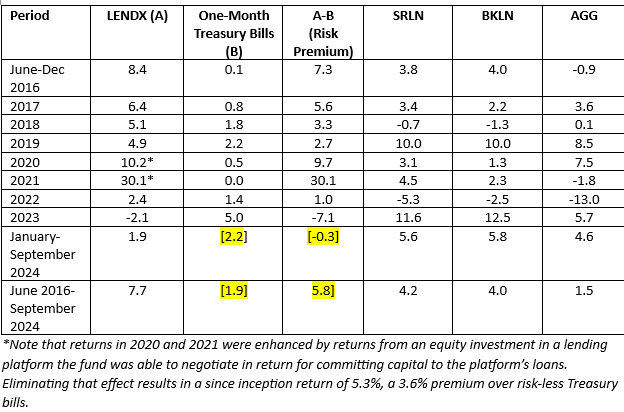
Due to the fund's strong performance through 2021, LENDX assets grew to around $2.4 billion. As in this case, in most economic cycles, the strong economy and performance led to a cyclical decline in credit standards. The rise in inflation and interest rates in 2022 led the fund to generate returns below expectations, including a small loss in 2023, which was otherwise a good year for other fixed-income assets as rates fell from peak levels. The rise in inflation led to wage growth falling below inflation for two years, an unusual event that contributed to the rise in credit losses.
Alternative Lending Has a Self-Healing Mechanism
As is the case with all risk assets, alternative lending has a self-healing mechanism that occurs after periods when realized returns are low or losses experienced. For example, in the case of reinsurance, when losses occurred due to the historic fires in California, not only did premiums rise dramatically, but underwriting standards tightened (such that you could not buy insurance if you had trees within 30 feet of your home, and all brush had to be cleared for another 30 feet). Deductibles increased significantly (reducing the risk of losses). Destruction from hurricanes in Florida caused the same events (rising premiums and deductibles and tougher underwriting standards).
Similarly, the poor returns of 2022 and 2023 led to capital flight out of alternative lending that in turn resulted in both a tightening of underwriting standards and a rise in credit spreads. The impact of the tightening standards on delinquencies can be seen in the chart below.
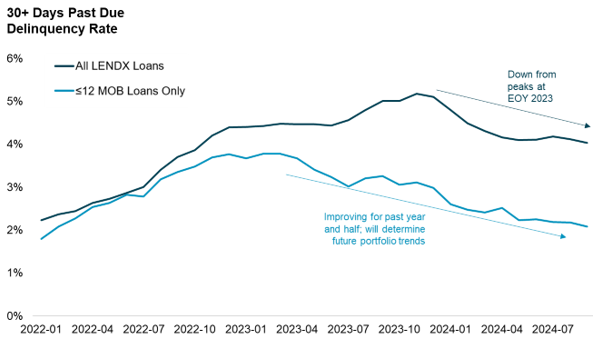
In addition, the reduced capital available to the lending platforms enabled providers, such as LENDX, to purchase new loans at a discount (instead of par), and negotiate “make whole” agreements covering some losses if default losses exceeded a benchmark. In addition, wages are once again rising faster than inflation, reducing the risk of credit losses.
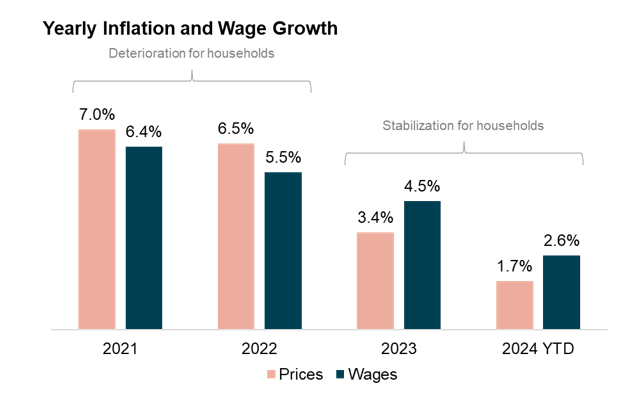
The fund's performance in the most recent months compared to the prior six months reflects the impacts of the improvement in credit quality, the increase in credit spreads, and slower inflation.
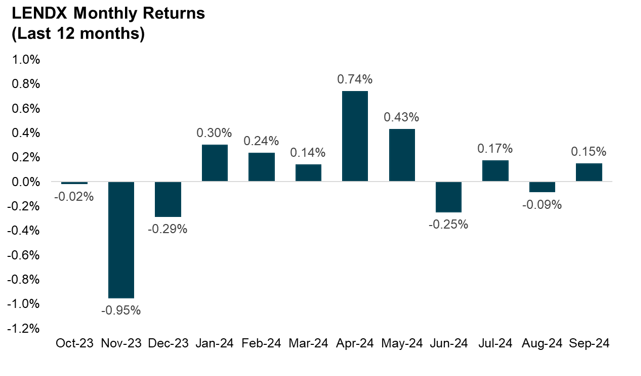
Note that the relatively short duration of about one year means that by the end of 2024, about two-thirds of LENDX’s loan portfolio is expected to be from loans made under the tighter underwriting standards and with higher spreads of 2023 and 2024.
Fund Returns Versus Investor Returns
Unfortunately, influenced by recency bias, individual investors tend to be performance chasers. This results in them buying after periods of strong performance (missing on the strong returns) and selling after periods of poor performance. The lack of discipline results in what is referred to as the “performance gap,” with investors earning returns that are below those of the very funds in which they invest. The following chart shows the performance gap for investors in LENDX.
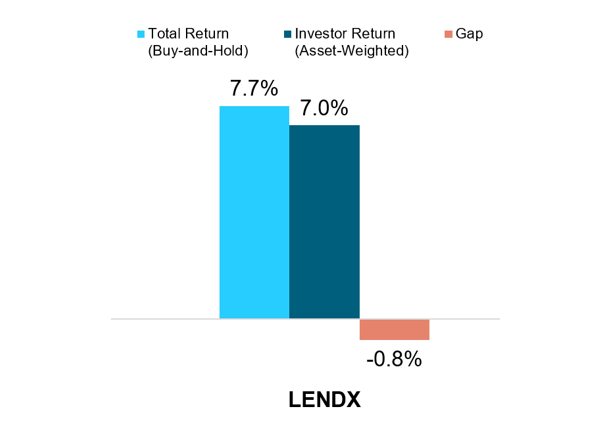
Investor Takeaway
The improvement in credit quality, along with the widening of spreads, should enable LENDX to earn a risk premium in the 4-5% range going forward. With Treasury bills yielding at about 5%, the expected return to LENDX is now in the range of 9-10%. Combined with the other attractive attributes of low volatility (around 2.5%), low duration risk (around 1 year) and almost no correlation to traditional stock and bond portfolio assets makes LENDX an attractive alternative to consider adding to a portfolio as a replacement for either equities or bonds, depending on your risk tolerance.
Larry Swedroe is the author or co-author of 18 books on investing, including his latest, Enrich Your Future: The Keys to Successful Investing.





